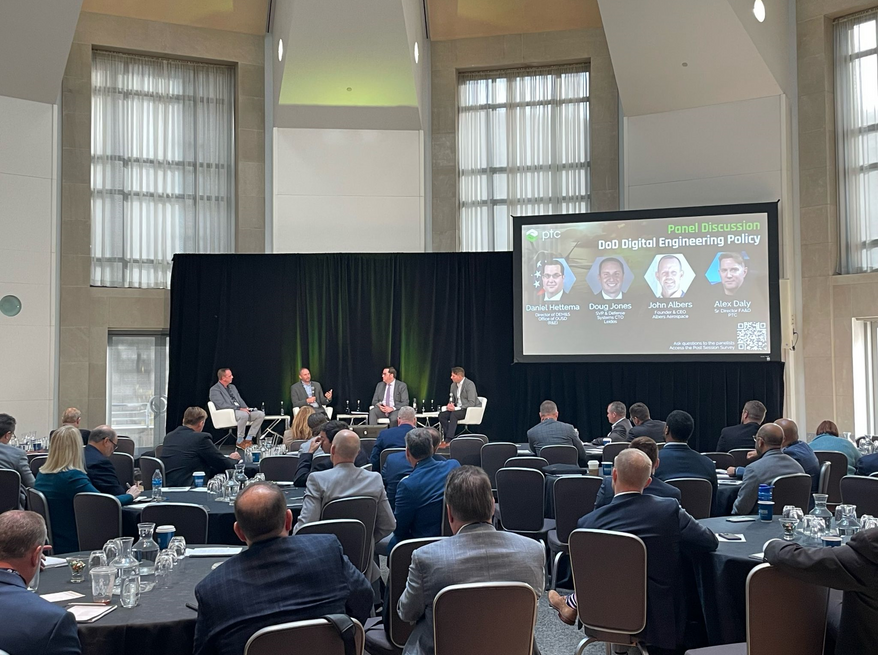PTC’s National Security Digital Thread Summit 2024 brought together key players from Congress, the Pentagon, Department of Energy, NASA and the US defense industrial base to discuss new technology adoption amid the backdrop of GPC urgency. Taking place in Washington, DC, the one-day Summit examined practical ideas for the national security enterprise to operate at the speed of relevance by working together and innovating faster.
The Summit’s agenda offered a combination of small group breakouts and lively panel discussions featuring leaders across government and defense, engineering and manufacturing, and software and technology. Discussions were focused on bold ideas, strategies, and technologies for keeping up with the digital age while addressing the industry's top challenges and opportunities. To kickoff the day, PTC's President and CEO, Neil Barua, welcomed the crowd and emphasized the importance of hearing directly from PTC’s customer base to address specific challenges.

Congressional perspectives
Following Neil’s introduction, PTC’s Alex Daly sat down with Rob Wittman, Vice Chairman of the House Armed Services Committee, for a spirited fireside chat. Their discussion touched on several pressing areas in the national security enterprise, including the CR, the move toward software-centricity in the DoD, the Defense Modernization Caucus, organizational dynamics between the DIU, OUSD R/E and CDAO, and ways in which digital engineering data sets will soon play a role in training LLMs.
Software-centricity
One of the Summit’s key themes was the need for defense organizations and manufacturers to shift from hardware-centricity to software-centricity. Panelists commented throughout the day how this shift will be essential for staying competitive while also meeting the DoD’s needs with software-centric programs and systems. The DoD has created an initiative to recruit a reservist force of senior tech executives from the private sector to serve part time. Their focus will be on addressing challenges in cybersecurity and data analytics and the force could grow into the thousands in the coming years.
Speed of relevance
A key issue addressed during the Summit is how traditional development cycles and processes are delaying deployment timelines, resulting in record production backlogs across the defense industrial base. Panelists discussed ways to deliver more effective defense solutions within shorter timeframes, while ensuring that defense programs can be quickly modified to meet changing requirements and emerging threats.

The DoD expects digital engineering policy to play a key role in supporting continuous improvement and adaptability through iterative development and rapid prototyping. Digital engineering tools like CAD, PLM and MBSE are reducing the time and cost of traditional development cycles, providing engineering teams with detailed digital models that they can simulate, test, and optimize early in the design process to identify potential issues before physical prototypes are built. This shifting to the left isn’t just accelerating development timelines, it's also helping to eliminate risk for products and systems that need to be produced, deployed, and maintained at increasingly large scales.
Quality
Quality was another hot topic at the Summit. On top of efficiency gains, digital engineering helps to improve the overall quality and reliability of defense systems by providing the foundation for an interconnected digital thread across all aspects of the product lifecycle, from concept to deployment and beyond. With this digital thread, teams can extend relevant data downstream or upstream to ensure that key stakeholders have access to accurate, real-time information when making critical decisions.
Collaboration
The Summit also highlighted how industry-wide collaboration is needed to achieve the rapid pace of innovation that modern warfare requires. The digital thread was discussed as a key means of enhancing collaboration between contractors, suppliers, partners, and other stakeholders including the warfighter. As an essential enabler of digital transformation, the digital thread supports the integration of data across enterprise organizations, allowing stakeholders in the defense industry to share real-time insights and make informed, data-driven decisions, while ensuring everyone is on the same page. This level of interconnectivity will only become increasingly important as more systems and programs leverage technologies like AI and machine learning.
Adapting to the modern world
The National Security Digital Thread Summit provided thoughtful discussions around ways in which the government and defense industrial base are connecting digital engineering with high-order strategic outcomes. PTC would like to extend a special thanks to everyone who attended, as well as to the panel moderators and sidebar hosts: Steve Dertien, Bill Gundrey, Mark Pranke, Jason Boone, Jeremy Morse, and Cletus D'Souza.
To continue building deterrence against global threats, the national security enterprise must keep its laser-sharp focus on agility, innovation, and collaboration. By doing so, we can ensure that our nation’s defense capabilities remain strong, adaptable, and ready to meet the demands of an infinitely complex and dynamic world.

Advancing the defense industry
Learn more about PTC’s solutions for the federal, aerospace, and defense industry.
Explore FA&D Solutions